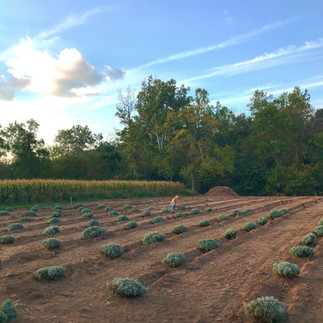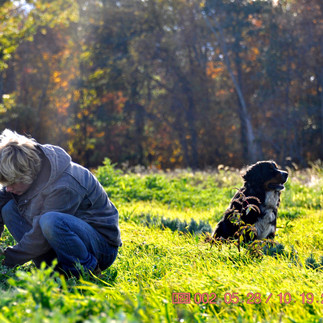Written for The Silos by Karen Hendricks
Of all the options for farm crops, why did we choose lavender at The Silos on Table Rock? It’s a question we are often asked—and the answers might surprise you.
Quite simply, there are lessons in growing lavender. That’s the vision that farm owner Lisa Grim had, in teaching her two sons the value of working hard.
And lavender can be a very challenging plant to grow. There are much “easier” crops to grow, but there is great reward in cultivating lavender because in doing so, it teaches the grower how to cultivate care, patience, and dedication in themselves as well.
“I wanted my boys to learn how to get something from nothing, how to produce a successful crop from the earth,” Lisa explains. “There is great value in hard work while respecting the land and nature.”

Putting Down Roots
The first lavender fields, here at The Silos at Table Rock, went into the earth in 2014. There was one very special person who was critical to the operation, Buzz. I could tell you his real name, but we’ll save that for another story here on our website. Besides, most people simply know him as Buzz.
“I’m so blessed, by all the work that Buzz put it, to make this farm what it is today,” Lisa says.
Part handyman, part farmer, Buzz is truly a jack of all trades. He is much more than a hired hand—he became a trusted expert and advisor as well. Thankfully, it didn’t faze him, when Lisa asked for his help in launching her lavender farm.
“My wife gardens,” says Buzz, “So I used some of her knowledge to learn how to do it.”
That first year—2014—they put 200 lavender plants in. It was back-breaking work for the small crew—Buzz, Lisa and her two sons, Wyatt and Jake.
“Buzz devised this thing—a metal rod and tube, and we used it to plant the lavender,” Lisa describes. “We did hundred foot lengths, for the rows, planting the lavender every six feet—all organized.”
At one point, Lisa remembers Buzz commenting, “Well, I never thought I’d be a lavender farmer,” which made everyone laugh.
Thinking back on that first field, there are more laughs for another reason: “The boys and I planted lavender all weekend,” Lisa recalls. “Rain was coming, and the boys wanted to stop, but we worked through the rain until we were finished.” The boys had their first lessons in labor and resilience.

Challenging Blooms
But lavender can be an extremely challenging plant to grow. They lost about 50% of that first crop.
“We had hoses out everywhere, that first summer,” Buzz says. “It was so dry, you could see where we had watered them.”
But every year, they learned a few new tips and tricks. They did soil tests, then learned how to add gravel sand and lime in each hole. Planting lavender in mounds, with plastic in between plants, kept weeds from creeping in, which made the gardening less labor-intensive. Still, every year, they add another 200-400 plants.
Lisa has attended the U.S. Lavender Association’s national conference in Charleston, South Carolina to learn more about this amazing, challenging yet rewarding, plant.
Why it is amazing? It has a long, ancient history—it’s even mentioned in the Bible. One of the reasons it’s been prized for some 2,500 years is its many uses well beyond its beautiful, bluish-purple blooms. Lavender is herbal, healing, fragrant, medicinal, and many people use it in cooking and baking as well—especially in southern France.
Lavender is actually native to the Mediterranean region—which is one of the reasons it can be challenging to grow elsewhere. That’s because its roots thrive in warm, dry climates. Lavender plants do not like wet soil. And several of our Adams County summers have seen a lot of rainfall at the Silos on Table Rock.
It’s actually ironic to think about lavender’s relationship to water. The word “lavender” is derived from the Latin “lavare,” meaning “to wash.” That’s because the ancient Romans used lavender to scent their baths and beds, like many of us still do today.

Full Circle Today, with lots of lessons under their belt, Lisa and her sons have about 900 thriving lavender plants. They’re still somewhat at the mercy of Mother Nature. Hot and dry summers provide the best growing conditions. But the mounds help the soil around the roots to drain better. And the rewards for their labors are many: The scenes and scents, as the gorgeous plants come into bloom, are incredible. Although harvesting the lavender is labor, this ancient plant is perhaps best known for its soothing, relaxing scent which helps many people sleep! Lisa knew all the hard work paid off, several years into their lavender farming experience. “Wyatt was out working in the lavender fields,” Lisa recalls. “And when he came inside, he said, ‘Mom, look out the window—look how beautiful the lavender looks.’ And that when I knew he got it. All that hard work was worth it.” Today, as you enjoy The Silos at Table Rock’s lavender logs, sachets, bath salts and other gifts, we hope you appreciate knowing a little bit more about this special plant. In a place as steeped in history and agriculture as Gettysburg is, we are honored to grow a plant with an ancient history and long line of helpful, meaningful uses as lavender.










































Comentários